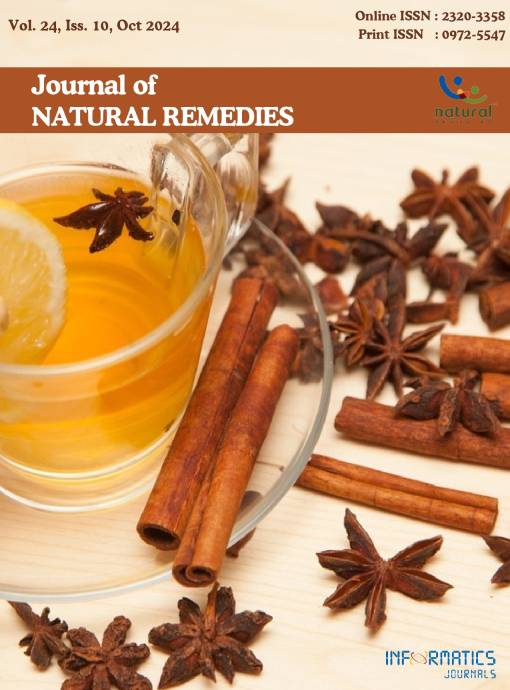Evaluation of Cardioprotective Activity of Corchorus aestuans L. Leaves
DOI:
https://doi.org/10.18311/jnr/2024/44997Keywords:
Cardioprotective, Corchorus aestuans L., Isoproterenol, Myocardial InfarctionAbstract
Background: The effectiveness of several medicinal herbs with antioxidant qualities in MI has been assessed and demonstrated. Corchorus aestuans L. is one such medicinal plant that has been shown to have hypocholesteremic and antioxidant properties. C. aestuans L. is also well-known for its bitter tonic, cardiotonic, and stomach relieving properties. Aim: In order to assess the impact of C. aestuans methanol extract against ISO-induced changes in myocardial enzymes, antioxidant status, and cardiac pathology in experimentally induced myocardial infarction, this study was conducted. Methods: Male wistar albino rats were used to create an Isoproterenol (ISO) induced Myocardial Infarction (MI) in order to study the possible cardiovascular preventative effects of the methanol extract of the medicinal plant C. aestuans. Six groups of eight animals each were created from the 180-250 g range of animals, and during the study, the animals in groups one (normal control) and two (model control) were given distilled water. Group three received ascorbic acid (250 mg/kg), while groups four to six received methanol extract of C. aestuans (MECA; 50, 100, and 150 mg/kg, respectively) once a day for 28 days. Animals in group’s two to six received the first dosage of ISO (100 mg/kg, S.C.) on day 27 and the second dose 24 hours later. Rats were anesthetized using chloroform, then their hearts were isolated and serum was collected. Twelve hours following the second large dose, the rats anesthetized, killed, and samples of their hearts and serum were taken. After the heart was cleaned with ice-cold saline, it was weighed. A histology study was conducted on heart tissue, while biochemical markers were analyzed in serum and heart homogenate. Results: When isoproterenol was administered, the concentrations of CK-MB (Creatinine Kinase - Myocardial Band), LDH (Lactate Dehydrogenase), and NA+ (Sodium) increased dramatically, but the concentrations of K+ (Potassium) and MDA (Malondialdehyde) dropped. The incidence of these alterations was dramatically decreased by ascorbic acid and MECA (Methanol extract of C. aestuans) treatment. Consequently, the cardioprotective effect can be explained by decreased levels of cardiac marker enzymes. Conclusion: MECA (50 mg / kg, 100 mg / kg and 150 mg /kg p.o. once for 28 days) attenuated serum enzymes and marker, increased tissue calcium and sodium levels, decreased potassium levels, and inhibited lipid peroxidation to significantly counteract the effect of experimentally induced MI.
Downloads
Metrics
Downloads
Published
How to Cite
Issue
Section
License
Copyright (c) 2024 Carol Macwan, B. N. Suhagia, Tejal G. Soni, Shahbaz S. Ahmed, Jaya Patel (Author)

This work is licensed under a Creative Commons Attribution 4.0 International License.
Accepted 2024-09-11
Published 2024-11-06
References
Gilski DJ, Borkenhagen B. Risk evaluation in action for cardiovascular health. Crit Care Nurse. 2005; 25(1):26–37. https://doi.org/10.4037/ccn2005.25.1.26
Velasco-Loyden G, Perez-Martinez L, Vidrio-Gomez S, Perez-Carreon JI, Sanchez VC. Cancer chemoprevention by an adenosine derivative in a model of cirrhosishepatocellular carcinoma induced by diethylnitrosamine in rats. Tumor Biol. 2017; 39(2):1–12. https://doi.org/10.1177/1010428317691190
Hegstad AC, Ytrehus K, Myklebust R, Jorgensen L. Ultrastructural changes in the myocardial myocytic mitochondria: Crucial step in the development of oxygen radical-induced damage in isolated rat hearts?. Basic Res Cardiol. 1994; 89:128-138. https://doi.org/10.1007/bf00788732
Cai Q, Rahn RO, Zhang R. Dietary flavonoids, quercetin, luteolin and genistein, reduce oxidative DNA damage and lipid peroxidation and quench free radicals. Cancer Lett. 1997; 119(1):99–107. https://doi.org/10.1016/s03043835(97)00261-9
Ginter E, Simko V, Panakova V. Antioxidants in health and disease. Bratislava Med J. 2014; 115(10):603-6.
Bandyopadhyay D, Chattopadhyay A, Ghosh G, Datta A. Oxidative stress-induced ischemic heart disease: Protection by antioxidants. Curr Med Chem. 2005; 11(3):369–387. https://doi.org/10.2174/0929867043456016
Satyavati GV, RainaMK, Sharma M. Medicinal Plants of India. Indian Council of Medical Research. 1976; 1-2:278– 281.
Khan MSY, Bano S, Javed K MM. A comprehensive review on the chemistry and pharmacology of Corchorus species-a source of cardiac glycosides, triterpenoids, ionones, flavonoids, coumarins, steroids and some other compounds. J Sci Ind Res. 2006; 65:283–298.
Wang J, Bo H, Meng X, Wu Y, Bao Y, Li Y. A simple and fast experimental model of myocardial infarction in the mouse. Texas Hear Inst J. 2006; 33(3):290-293. PMID: 17041683
Rosalki BS. A simple colorimetric method for the determination of serum alpha-hydroxybutyric dehydrogenase activity. J Clin Pathol. 1962; 15566–568). https://doi.org/10.1136/jcp.15.6.566
Mohanty I, Singh AD, Dinda A, Joshi S, Talwar KK, Gupta SK. Protective effects of Curcuma longa on ischemiareperfusion induced myocardial injuries and their mechanisms. Life Sci. Elsevier. 2004; 75(14):1701–1711.
Bolton S, Bon C. Pharmaceutical statistics: Practical and clinical applications. 2003; 4:1-756.

 Carol Macwan
Carol Macwan









 0.35
0.35 24
24 0.161
0.161